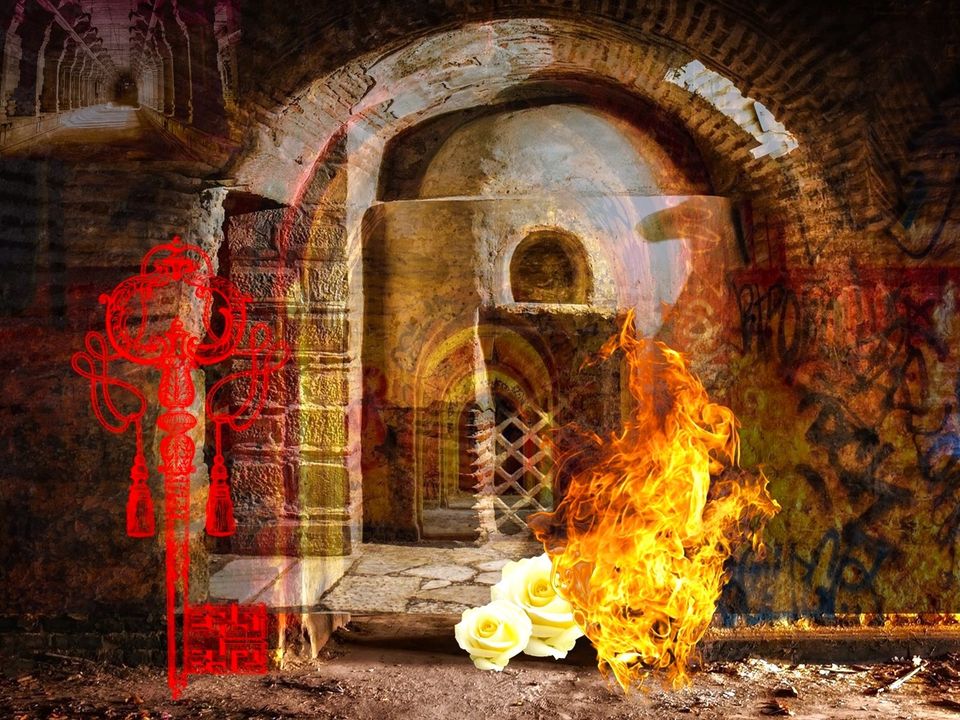House of the Catacombs: On the Threshold of Hidden Things

The space unexpectedly opened into a vast realm, undoubtedly unnerving those who discovered it, a cave used by people of another time, exquisitely furnished with statuary and networks of tunnels. The owner of an ordinary house in Turkey had begun to construct additional rooms when, by chance, he discovered an extraordinary connection to history, there, beneath his home. Similarly, dwellings on the Island of Malta are said to have doorway access to catacombs; innumerable chambers and labyrinths, long abandoned by their makers, languish underfoot, topped by the island’s magnificent beauty. How strange it would be to own such a house, a private space abutted by vast regions of ancient life, a homely kitchen and bedrooms perched nervously over the abyss. Consider the atmosphere in question.
An effective dwelling must shelter as well as comfort those within its walls, being primarily a refuge from the world’s hazards, from the lurking criminal who might be deterred by its locked doors, to the dark storms of winter repelled by its roof. Beyond this, a home carries with it certain semantic burdens, as it must be inviting and pleasant, while sheltering occupants from noonday heat and the dangers of night. An image of homelife brings to mind a furnished table, the glow of soft light issuing from windows, and flowers of the season gathering moisture outside. The hours of dusk and the arrival of loved ones for a meal complete the picture. This is a home. By contrast, a house—a potentially cold and anonymous structure—can linger over the abyss without issue; it promises physical protection but never the assurance of emotional support or a welcoming embrace. When rains are repelled, and intruders stymied, the house has done its job.
And what about the dwelling that sits, either knowingly or unknowingly, over ancient catacombs? What more can be said regarding its situation as a liminal space, a threshold dividing self from the unknowable other, modern life from the haunting elegance of antiquity? It all depends on the homeowner in question. For some, the ambience of history is not only unavoidable but enriching, as it offers character to a residence and a sense of the unique—not a bland subdivision but a memorial to the ancients or a curio cabinet from ages past. Again, the role of a dwelling beyond its rudimentary functions is truly subjective; personal taste prevails.
Could you sleep comfortably, perhaps with the family pet at your feet, knowing that the cellar door—an old piece of wood barely able to offer separation—is all that stands between you and networks of tunnels and chambers, tombs yet to be discovered, and a history likely gruesome in its explicit details? If you could, I applaud you. Now, let’s return to the notion of liminal spaces, thresholds and their greater significance. Here, the idea of order begins to gain momentum, playing off the shadows cast by catacombs, which serve conveniently as symbols of chaos.
More than providing separation, a transition between the known world and that which looms in uncertainty, the house promises order, a region where predictability overcomes disorder by design, geometry being very much a part of things—a series of angled divisions keeping the family safe at night. In relation to our present subject, the idea of mathematically defined space is interesting. It brings to mind Gaston Bachelard’s 1958 book, The Poetics of Space and the chapter related to shells.
The snail presents us with rich domestic imagery, its soft form residing in a realm of mathematical hardness; Bachelard reminds us that “Ammonites built their homes around the axis of a logarithmic spiral.” In its most effective and pleasing expression, a dwelling’s order can repel chaos from the outside world, while manifesting beauty. Along these lines, Bachelard references the writing of Paul Valery, who noted that “A crystal, a flower or a shell stands out from the usual disorder that characterizes most perceptible things” (p. 105). This is one view, amid many others, on the orderliness of natural formations. Yet, in our present study, architecture provides us with a different perspective; the well-designed dwelling—easily perceived for its great size—stands in contrast to the disorder of imperceptible things. And it does so quite convincingly. Imagine a house, the symbol of domestic order, presiding over sprawling subterranean depths, defying shadows to overtake it—Poetics of Space powerfully engaged.
Those who came before us left their ritual spaces beneath our feet, amid uncharted caverns and interruptions of darkness. Perhaps the geometry of built environments can shelter us from these depths, as they compete with the splendor of logarithmic shells and the rich aesthetics of nature. What we can say with certainty, however, is that both the house and the snail’s shell serve as points of transition, dividing sheltered space from the world of external uncertainty. In both cases, homeowners must hope that their walls of order will stand against the chaos of time.
As vulnerable as a snail encased in its shell, the human who sleeps above catacombs rests in bed, believing that his well-ordered house will fend off the disorderly intrusions of history. Time, as they say, will tell. From the vantagepoint of personal taste, I’ve drawn my own conclusions; burial places, as well as sites of ancient ritual, certainly don’t offer a sense of coziness and wellbeing. A house of the catacombs, a place of dark transitions and the secrets of history, is not to everyone’s liking.